Contemporary Business Economics: Demand, Supply & Theories - Tesco
VerifiedAdded on 2023/06/16
|14
|3494
|263
Report
AI Summary
This report delves into the core principles of business economics, focusing on the laws of demand and supply, and contrasting traditional and contemporary economic theories. Using Tesco as a case study, the report explains the inverse relationship between price and quantity demanded, factors affecting demand such as income and customer preferences, and the dynamics of the supply curve. It further compares Adam Smith's classical free market theory and Karl Marx's Marxist theory with modern theories like the Nudge theory, highlighting their implications for businesses. The analysis emphasizes the importance for companies like Tesco to understand these economic principles to optimize their strategies related to production, pricing, and marketing to align with consumer behavior and market dynamics.
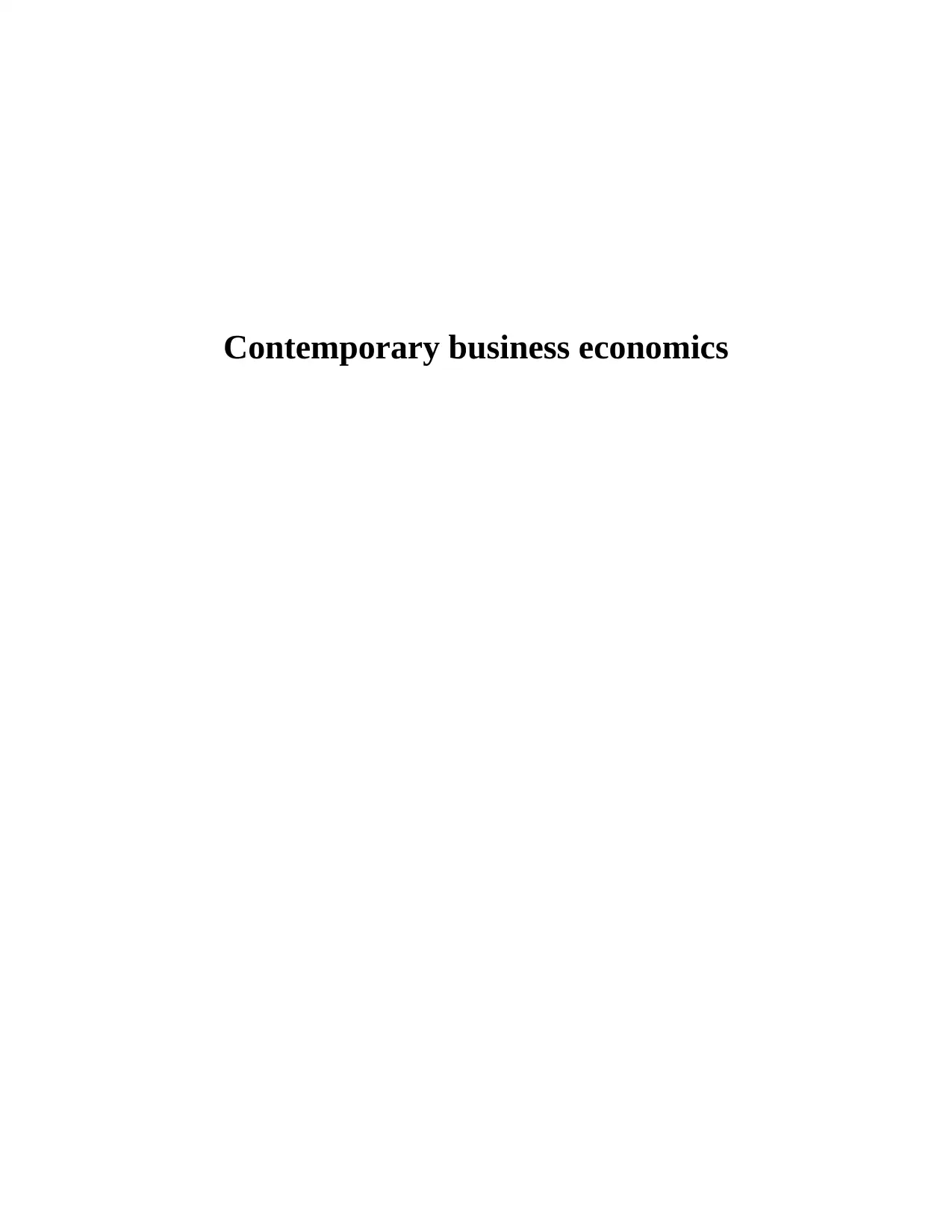
Contemporary business economics
Paraphrase This Document
Need a fresh take? Get an instant paraphrase of this document with our AI Paraphraser
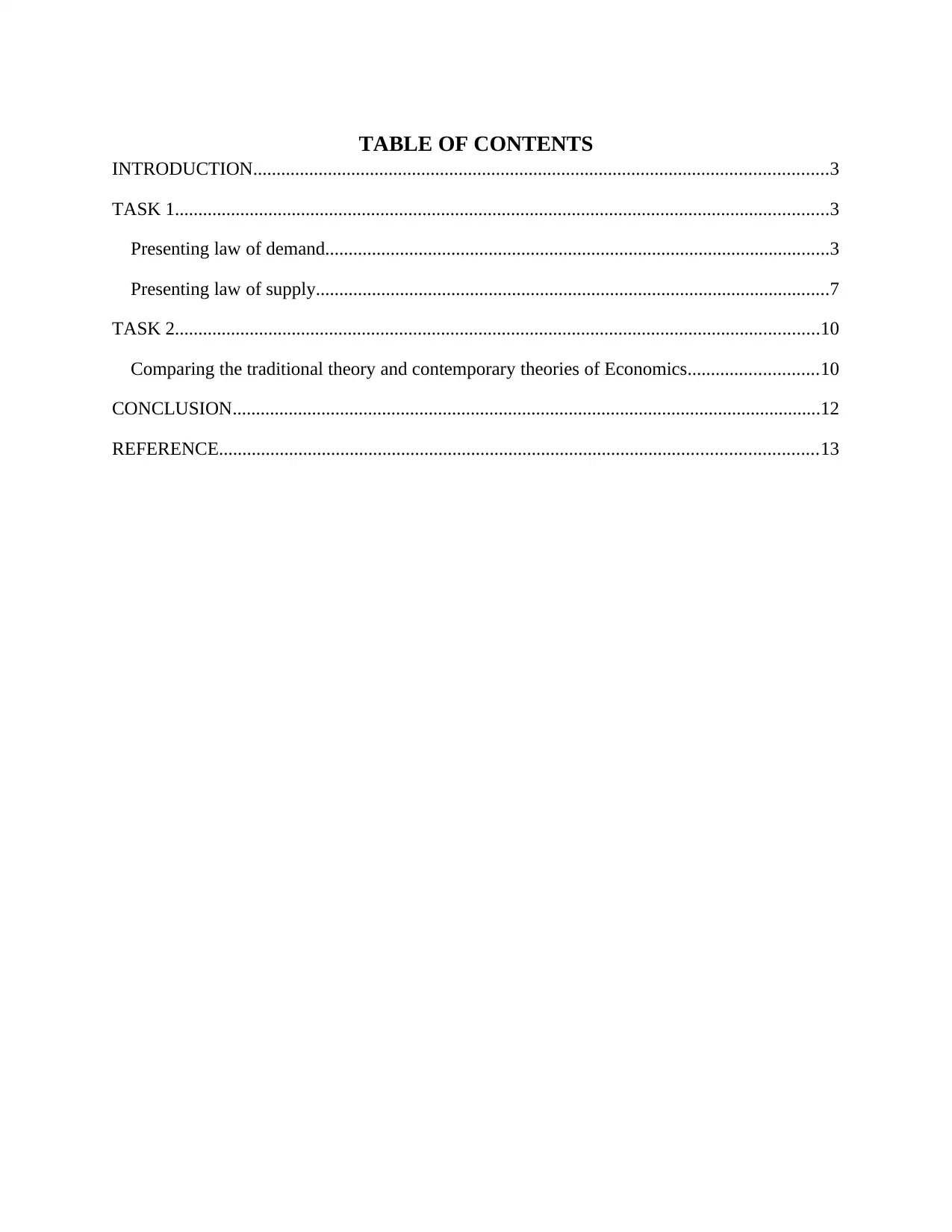
TABLE OF CONTENTS
INTRODUCTION...........................................................................................................................3
TASK 1............................................................................................................................................3
Presenting law of demand............................................................................................................3
Presenting law of supply..............................................................................................................7
TASK 2..........................................................................................................................................10
Comparing the traditional theory and contemporary theories of Economics............................10
CONCLUSION..............................................................................................................................12
REFERENCE................................................................................................................................13
INTRODUCTION...........................................................................................................................3
TASK 1............................................................................................................................................3
Presenting law of demand............................................................................................................3
Presenting law of supply..............................................................................................................7
TASK 2..........................................................................................................................................10
Comparing the traditional theory and contemporary theories of Economics............................10
CONCLUSION..............................................................................................................................12
REFERENCE................................................................................................................................13
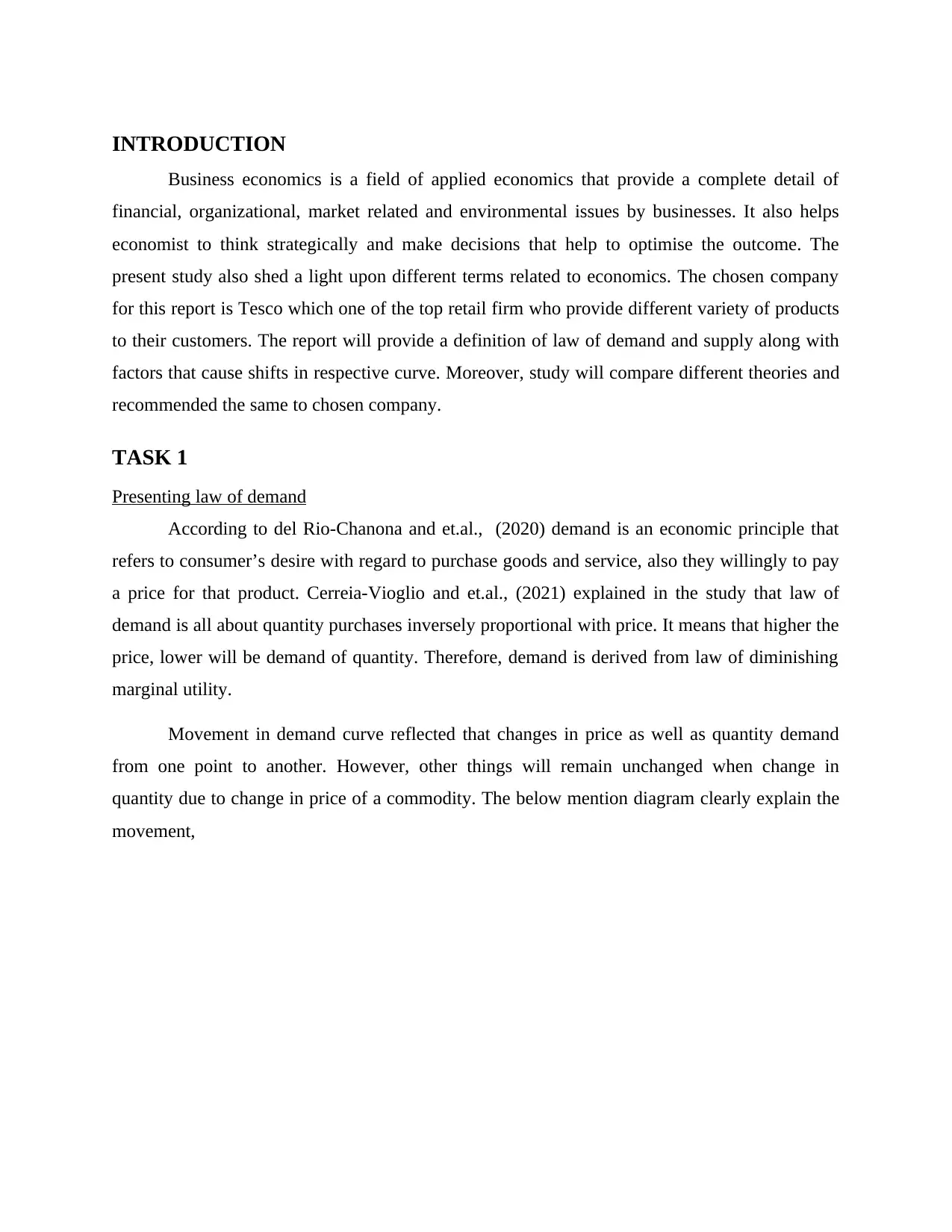
INTRODUCTION
Business economics is a field of applied economics that provide a complete detail of
financial, organizational, market related and environmental issues by businesses. It also helps
economist to think strategically and make decisions that help to optimise the outcome. The
present study also shed a light upon different terms related to economics. The chosen company
for this report is Tesco which one of the top retail firm who provide different variety of products
to their customers. The report will provide a definition of law of demand and supply along with
factors that cause shifts in respective curve. Moreover, study will compare different theories and
recommended the same to chosen company.
TASK 1
Presenting law of demand
According to del Rio-Chanona and et.al., (2020) demand is an economic principle that
refers to consumer’s desire with regard to purchase goods and service, also they willingly to pay
a price for that product. Cerreia-Vioglio and et.al., (2021) explained in the study that law of
demand is all about quantity purchases inversely proportional with price. It means that higher the
price, lower will be demand of quantity. Therefore, demand is derived from law of diminishing
marginal utility.
Movement in demand curve reflected that changes in price as well as quantity demand
from one point to another. However, other things will remain unchanged when change in
quantity due to change in price of a commodity. The below mention diagram clearly explain the
movement,
Business economics is a field of applied economics that provide a complete detail of
financial, organizational, market related and environmental issues by businesses. It also helps
economist to think strategically and make decisions that help to optimise the outcome. The
present study also shed a light upon different terms related to economics. The chosen company
for this report is Tesco which one of the top retail firm who provide different variety of products
to their customers. The report will provide a definition of law of demand and supply along with
factors that cause shifts in respective curve. Moreover, study will compare different theories and
recommended the same to chosen company.
TASK 1
Presenting law of demand
According to del Rio-Chanona and et.al., (2020) demand is an economic principle that
refers to consumer’s desire with regard to purchase goods and service, also they willingly to pay
a price for that product. Cerreia-Vioglio and et.al., (2021) explained in the study that law of
demand is all about quantity purchases inversely proportional with price. It means that higher the
price, lower will be demand of quantity. Therefore, demand is derived from law of diminishing
marginal utility.
Movement in demand curve reflected that changes in price as well as quantity demand
from one point to another. However, other things will remain unchanged when change in
quantity due to change in price of a commodity. The below mention diagram clearly explain the
movement,
⊘ This is a preview!⊘
Do you want full access?
Subscribe today to unlock all pages.

Trusted by 1+ million students worldwide
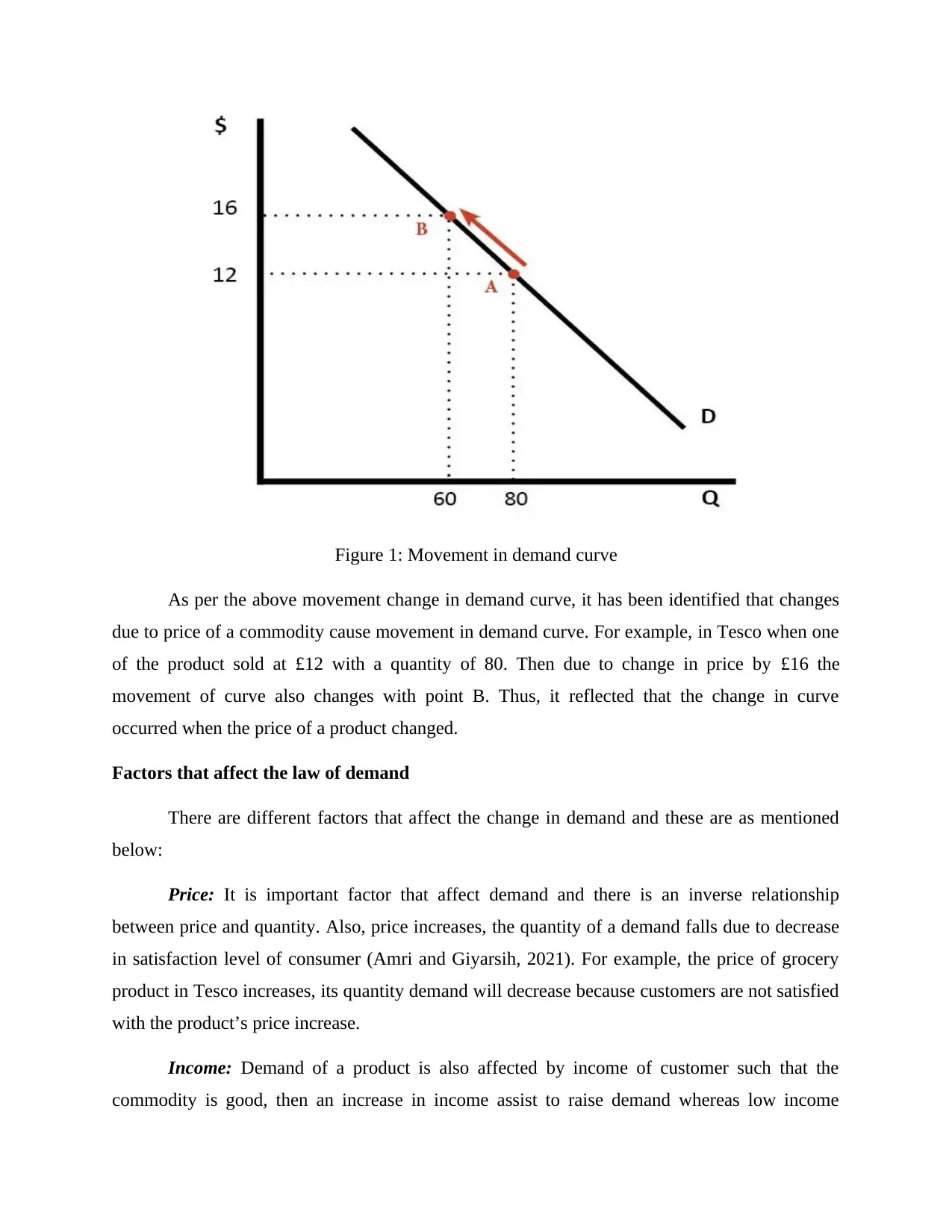
Figure 1: Movement in demand curve
As per the above movement change in demand curve, it has been identified that changes
due to price of a commodity cause movement in demand curve. For example, in Tesco when one
of the product sold at £12 with a quantity of 80. Then due to change in price by £16 the
movement of curve also changes with point B. Thus, it reflected that the change in curve
occurred when the price of a product changed.
Factors that affect the law of demand
There are different factors that affect the change in demand and these are as mentioned
below:
Price: It is important factor that affect demand and there is an inverse relationship
between price and quantity. Also, price increases, the quantity of a demand falls due to decrease
in satisfaction level of consumer (Amri and Giyarsih, 2021). For example, the price of grocery
product in Tesco increases, its quantity demand will decrease because customers are not satisfied
with the product’s price increase.
Income: Demand of a product is also affected by income of customer such that the
commodity is good, then an increase in income assist to raise demand whereas low income
As per the above movement change in demand curve, it has been identified that changes
due to price of a commodity cause movement in demand curve. For example, in Tesco when one
of the product sold at £12 with a quantity of 80. Then due to change in price by £16 the
movement of curve also changes with point B. Thus, it reflected that the change in curve
occurred when the price of a product changed.
Factors that affect the law of demand
There are different factors that affect the change in demand and these are as mentioned
below:
Price: It is important factor that affect demand and there is an inverse relationship
between price and quantity. Also, price increases, the quantity of a demand falls due to decrease
in satisfaction level of consumer (Amri and Giyarsih, 2021). For example, the price of grocery
product in Tesco increases, its quantity demand will decrease because customers are not satisfied
with the product’s price increase.
Income: Demand of a product is also affected by income of customer such that the
commodity is good, then an increase in income assist to raise demand whereas low income
Paraphrase This Document
Need a fresh take? Get an instant paraphrase of this document with our AI Paraphraser
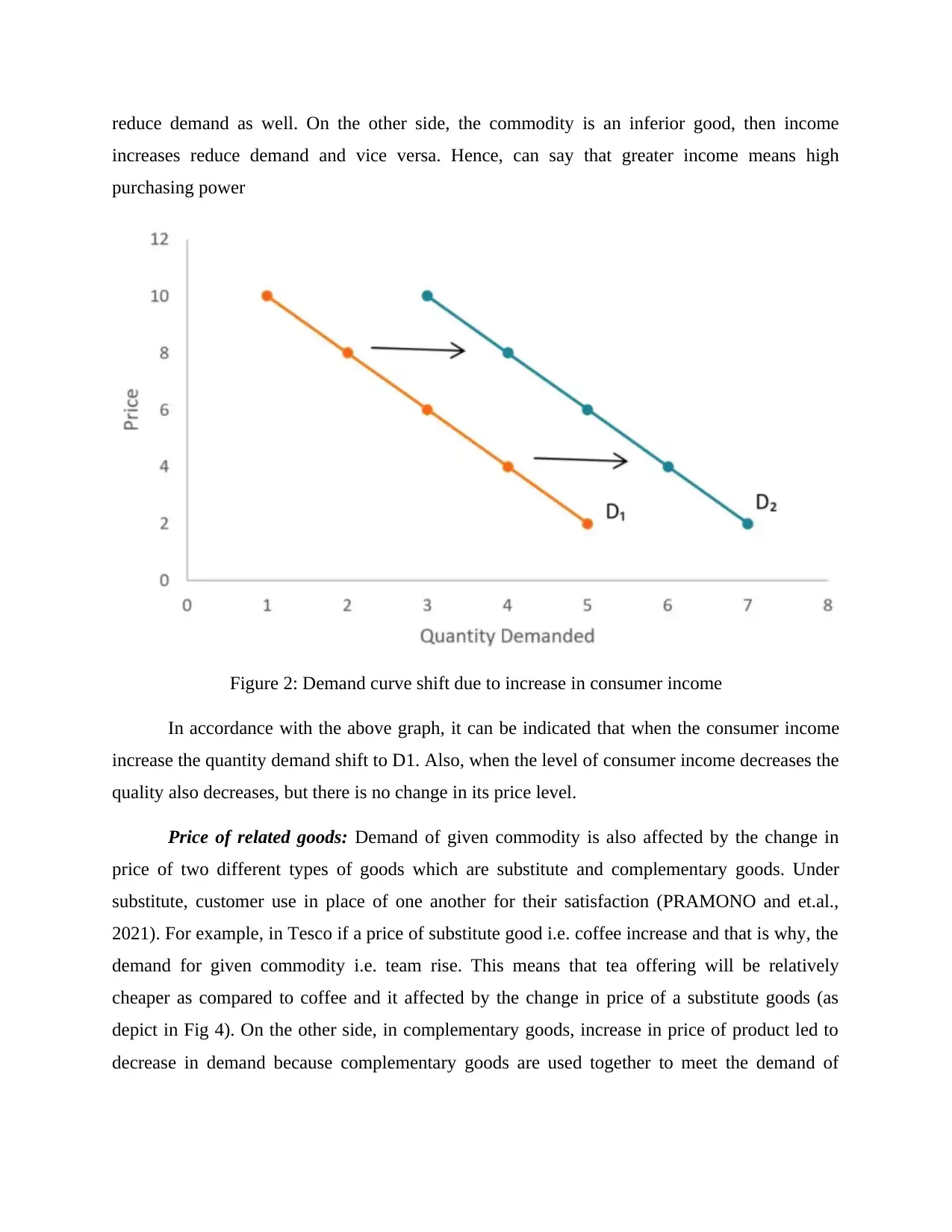
reduce demand as well. On the other side, the commodity is an inferior good, then income
increases reduce demand and vice versa. Hence, can say that greater income means high
purchasing power
Figure 2: Demand curve shift due to increase in consumer income
In accordance with the above graph, it can be indicated that when the consumer income
increase the quantity demand shift to D1. Also, when the level of consumer income decreases the
quality also decreases, but there is no change in its price level.
Price of related goods: Demand of given commodity is also affected by the change in
price of two different types of goods which are substitute and complementary goods. Under
substitute, customer use in place of one another for their satisfaction (PRAMONO and et.al.,
2021). For example, in Tesco if a price of substitute good i.e. coffee increase and that is why, the
demand for given commodity i.e. team rise. This means that tea offering will be relatively
cheaper as compared to coffee and it affected by the change in price of a substitute goods (as
depict in Fig 4). On the other side, in complementary goods, increase in price of product led to
decrease in demand because complementary goods are used together to meet the demand of
increases reduce demand and vice versa. Hence, can say that greater income means high
purchasing power
Figure 2: Demand curve shift due to increase in consumer income
In accordance with the above graph, it can be indicated that when the consumer income
increase the quantity demand shift to D1. Also, when the level of consumer income decreases the
quality also decreases, but there is no change in its price level.
Price of related goods: Demand of given commodity is also affected by the change in
price of two different types of goods which are substitute and complementary goods. Under
substitute, customer use in place of one another for their satisfaction (PRAMONO and et.al.,
2021). For example, in Tesco if a price of substitute good i.e. coffee increase and that is why, the
demand for given commodity i.e. team rise. This means that tea offering will be relatively
cheaper as compared to coffee and it affected by the change in price of a substitute goods (as
depict in Fig 4). On the other side, in complementary goods, increase in price of product led to
decrease in demand because complementary goods are used together to meet the demand of
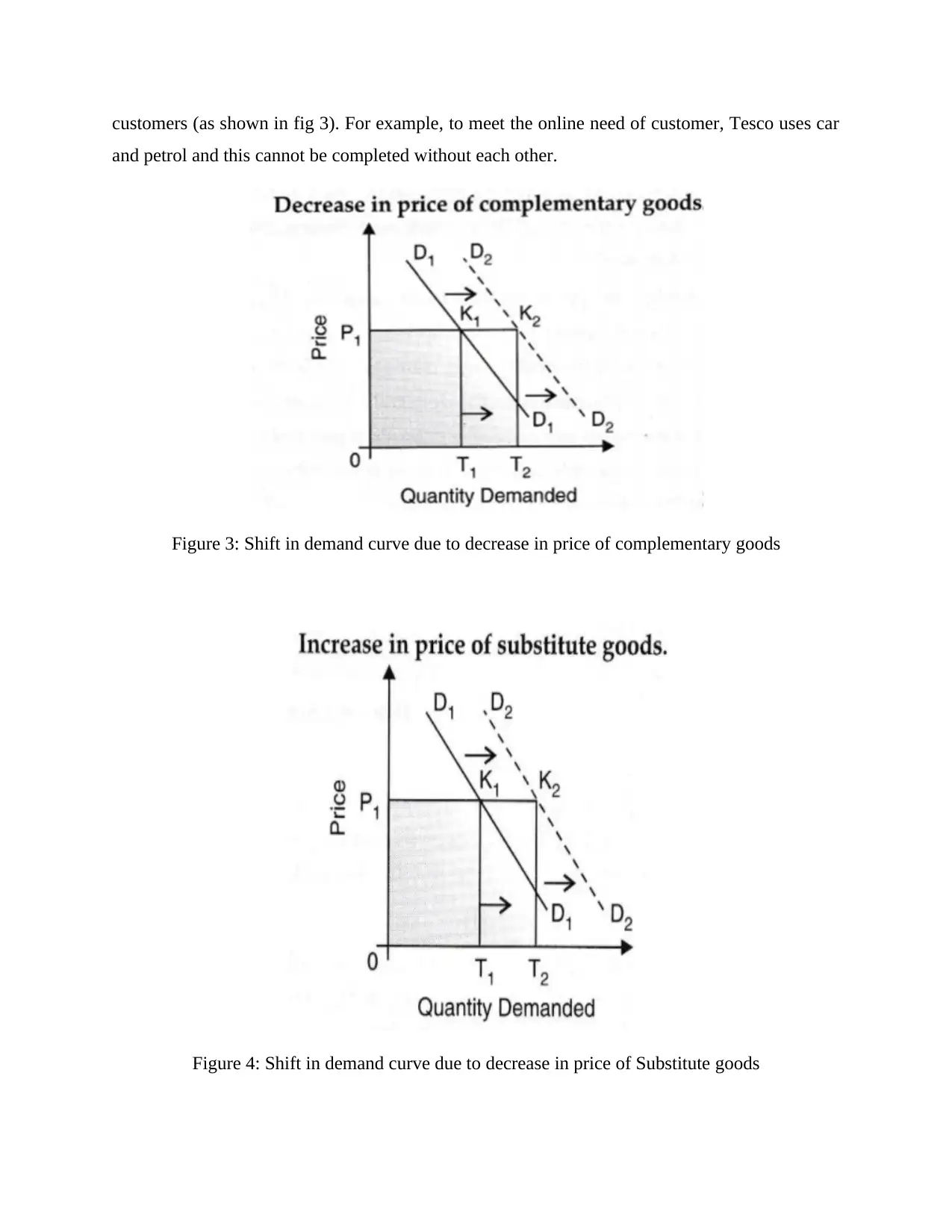
customers (as shown in fig 3). For example, to meet the online need of customer, Tesco uses car
and petrol and this cannot be completed without each other.
Figure 3: Shift in demand curve due to decrease in price of complementary goods
Figure 4: Shift in demand curve due to decrease in price of Substitute goods
and petrol and this cannot be completed without each other.
Figure 3: Shift in demand curve due to decrease in price of complementary goods
Figure 4: Shift in demand curve due to decrease in price of Substitute goods
⊘ This is a preview!⊘
Do you want full access?
Subscribe today to unlock all pages.

Trusted by 1+ million students worldwide
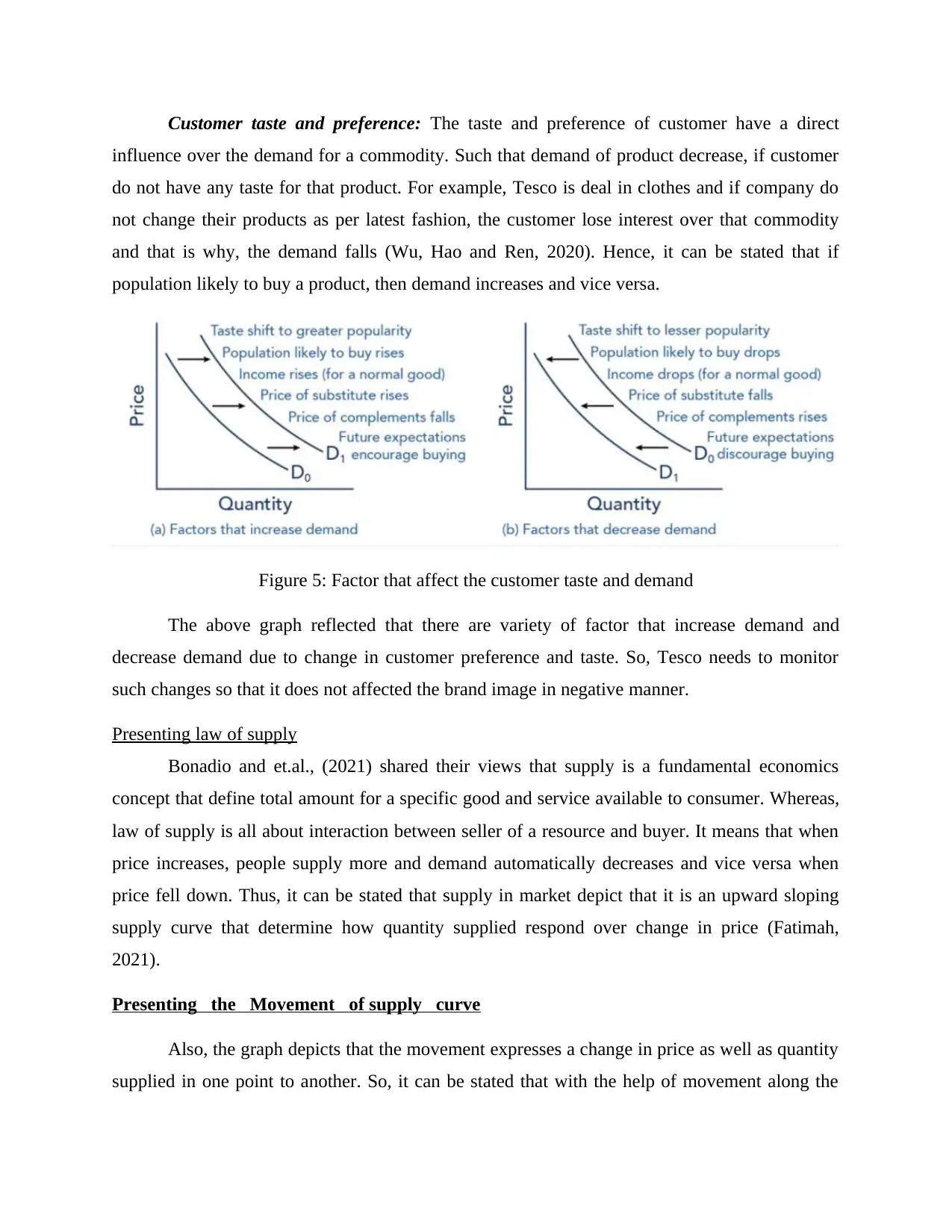
Customer taste and preference: The taste and preference of customer have a direct
influence over the demand for a commodity. Such that demand of product decrease, if customer
do not have any taste for that product. For example, Tesco is deal in clothes and if company do
not change their products as per latest fashion, the customer lose interest over that commodity
and that is why, the demand falls (Wu, Hao and Ren, 2020). Hence, it can be stated that if
population likely to buy a product, then demand increases and vice versa.
Figure 5: Factor that affect the customer taste and demand
The above graph reflected that there are variety of factor that increase demand and
decrease demand due to change in customer preference and taste. So, Tesco needs to monitor
such changes so that it does not affected the brand image in negative manner.
Presenting law of supply
Bonadio and et.al., (2021) shared their views that supply is a fundamental economics
concept that define total amount for a specific good and service available to consumer. Whereas,
law of supply is all about interaction between seller of a resource and buyer. It means that when
price increases, people supply more and demand automatically decreases and vice versa when
price fell down. Thus, it can be stated that supply in market depict that it is an upward sloping
supply curve that determine how quantity supplied respond over change in price (Fatimah,
2021).
Presenting the Movement of supply curve
Also, the graph depicts that the movement expresses a change in price as well as quantity
supplied in one point to another. So, it can be stated that with the help of movement along the
influence over the demand for a commodity. Such that demand of product decrease, if customer
do not have any taste for that product. For example, Tesco is deal in clothes and if company do
not change their products as per latest fashion, the customer lose interest over that commodity
and that is why, the demand falls (Wu, Hao and Ren, 2020). Hence, it can be stated that if
population likely to buy a product, then demand increases and vice versa.
Figure 5: Factor that affect the customer taste and demand
The above graph reflected that there are variety of factor that increase demand and
decrease demand due to change in customer preference and taste. So, Tesco needs to monitor
such changes so that it does not affected the brand image in negative manner.
Presenting law of supply
Bonadio and et.al., (2021) shared their views that supply is a fundamental economics
concept that define total amount for a specific good and service available to consumer. Whereas,
law of supply is all about interaction between seller of a resource and buyer. It means that when
price increases, people supply more and demand automatically decreases and vice versa when
price fell down. Thus, it can be stated that supply in market depict that it is an upward sloping
supply curve that determine how quantity supplied respond over change in price (Fatimah,
2021).
Presenting the Movement of supply curve
Also, the graph depicts that the movement expresses a change in price as well as quantity
supplied in one point to another. So, it can be stated that with the help of movement along the
Paraphrase This Document
Need a fresh take? Get an instant paraphrase of this document with our AI Paraphraser
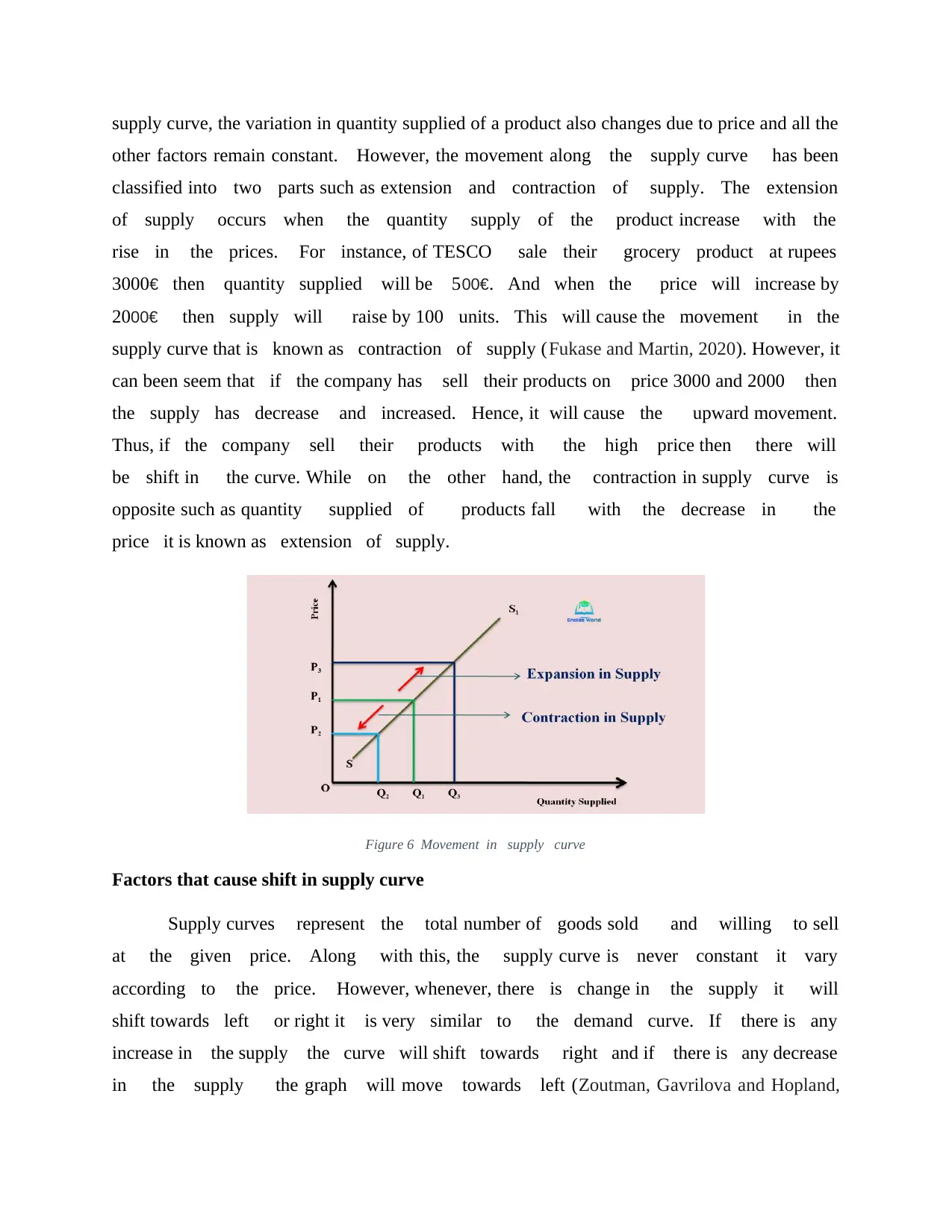
supply curve, the variation in quantity supplied of a product also changes due to price and all the
other factors remain constant. However, the movement along the supply curve has been
classified into two parts such as extension and contraction of supply. The extension
of supply occurs when the quantity supply of the product increase with the
rise in the prices. For instance, of TESCO sale their grocery product at rupees
3000€ then quantity supplied will be 500€. And when the price will increase by
2000€ then supply will raise by 100 units. This will cause the movement in the
supply curve that is known as contraction of supply (Fukase and Martin, 2020). However, it
can been seem that if the company has sell their products on price 3000 and 2000 then
the supply has decrease and increased. Hence, it will cause the upward movement.
Thus, if the company sell their products with the high price then there will
be shift in the curve. While on the other hand, the contraction in supply curve is
opposite such as quantity supplied of products fall with the decrease in the
price it is known as extension of supply.
Figure 6 Movement in supply curve
Factors that cause shift in supply curve
Supply curves represent the total number of goods sold and willing to sell
at the given price. Along with this, the supply curve is never constant it vary
according to the price. However, whenever, there is change in the supply it will
shift towards left or right it is very similar to the demand curve. If there is any
increase in the supply the curve will shift towards right and if there is any decrease
in the supply the graph will move towards left (Zoutman, Gavrilova and Hopland,
other factors remain constant. However, the movement along the supply curve has been
classified into two parts such as extension and contraction of supply. The extension
of supply occurs when the quantity supply of the product increase with the
rise in the prices. For instance, of TESCO sale their grocery product at rupees
3000€ then quantity supplied will be 500€. And when the price will increase by
2000€ then supply will raise by 100 units. This will cause the movement in the
supply curve that is known as contraction of supply (Fukase and Martin, 2020). However, it
can been seem that if the company has sell their products on price 3000 and 2000 then
the supply has decrease and increased. Hence, it will cause the upward movement.
Thus, if the company sell their products with the high price then there will
be shift in the curve. While on the other hand, the contraction in supply curve is
opposite such as quantity supplied of products fall with the decrease in the
price it is known as extension of supply.
Figure 6 Movement in supply curve
Factors that cause shift in supply curve
Supply curves represent the total number of goods sold and willing to sell
at the given price. Along with this, the supply curve is never constant it vary
according to the price. However, whenever, there is change in the supply it will
shift towards left or right it is very similar to the demand curve. If there is any
increase in the supply the curve will shift towards right and if there is any decrease
in the supply the graph will move towards left (Zoutman, Gavrilova and Hopland,
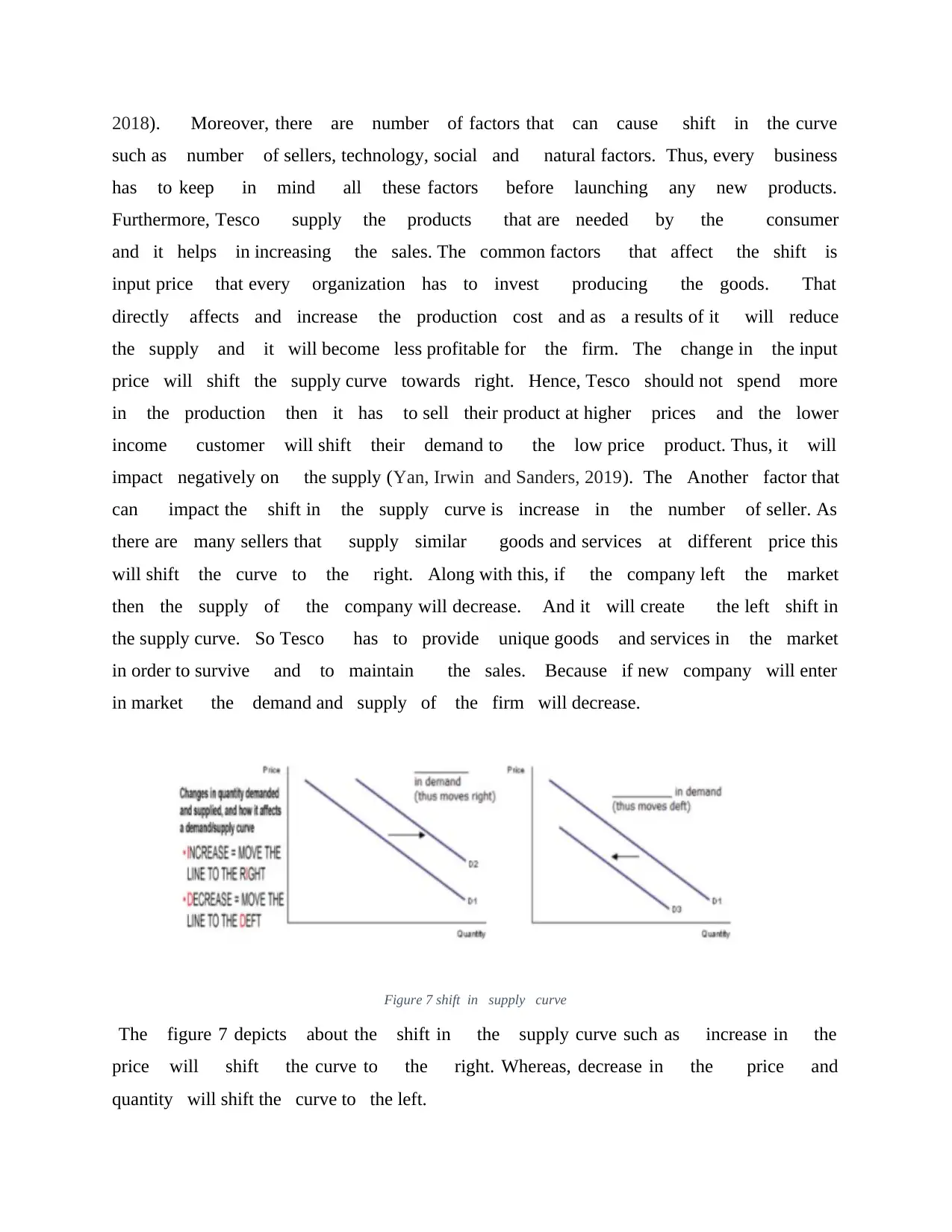
2018). Moreover, there are number of factors that can cause shift in the curve
such as number of sellers, technology, social and natural factors. Thus, every business
has to keep in mind all these factors before launching any new products.
Furthermore, Tesco supply the products that are needed by the consumer
and it helps in increasing the sales. The common factors that affect the shift is
input price that every organization has to invest producing the goods. That
directly affects and increase the production cost and as a results of it will reduce
the supply and it will become less profitable for the firm. The change in the input
price will shift the supply curve towards right. Hence, Tesco should not spend more
in the production then it has to sell their product at higher prices and the lower
income customer will shift their demand to the low price product. Thus, it will
impact negatively on the supply (Yan, Irwin and Sanders, 2019). The Another factor that
can impact the shift in the supply curve is increase in the number of seller. As
there are many sellers that supply similar goods and services at different price this
will shift the curve to the right. Along with this, if the company left the market
then the supply of the company will decrease. And it will create the left shift in
the supply curve. So Tesco has to provide unique goods and services in the market
in order to survive and to maintain the sales. Because if new company will enter
in market the demand and supply of the firm will decrease.
Figure 7 shift in supply curve
The figure 7 depicts about the shift in the supply curve such as increase in the
price will shift the curve to the right. Whereas, decrease in the price and
quantity will shift the curve to the left.
such as number of sellers, technology, social and natural factors. Thus, every business
has to keep in mind all these factors before launching any new products.
Furthermore, Tesco supply the products that are needed by the consumer
and it helps in increasing the sales. The common factors that affect the shift is
input price that every organization has to invest producing the goods. That
directly affects and increase the production cost and as a results of it will reduce
the supply and it will become less profitable for the firm. The change in the input
price will shift the supply curve towards right. Hence, Tesco should not spend more
in the production then it has to sell their product at higher prices and the lower
income customer will shift their demand to the low price product. Thus, it will
impact negatively on the supply (Yan, Irwin and Sanders, 2019). The Another factor that
can impact the shift in the supply curve is increase in the number of seller. As
there are many sellers that supply similar goods and services at different price this
will shift the curve to the right. Along with this, if the company left the market
then the supply of the company will decrease. And it will create the left shift in
the supply curve. So Tesco has to provide unique goods and services in the market
in order to survive and to maintain the sales. Because if new company will enter
in market the demand and supply of the firm will decrease.
Figure 7 shift in supply curve
The figure 7 depicts about the shift in the supply curve such as increase in the
price will shift the curve to the right. Whereas, decrease in the price and
quantity will shift the curve to the left.
⊘ This is a preview!⊘
Do you want full access?
Subscribe today to unlock all pages.

Trusted by 1+ million students worldwide
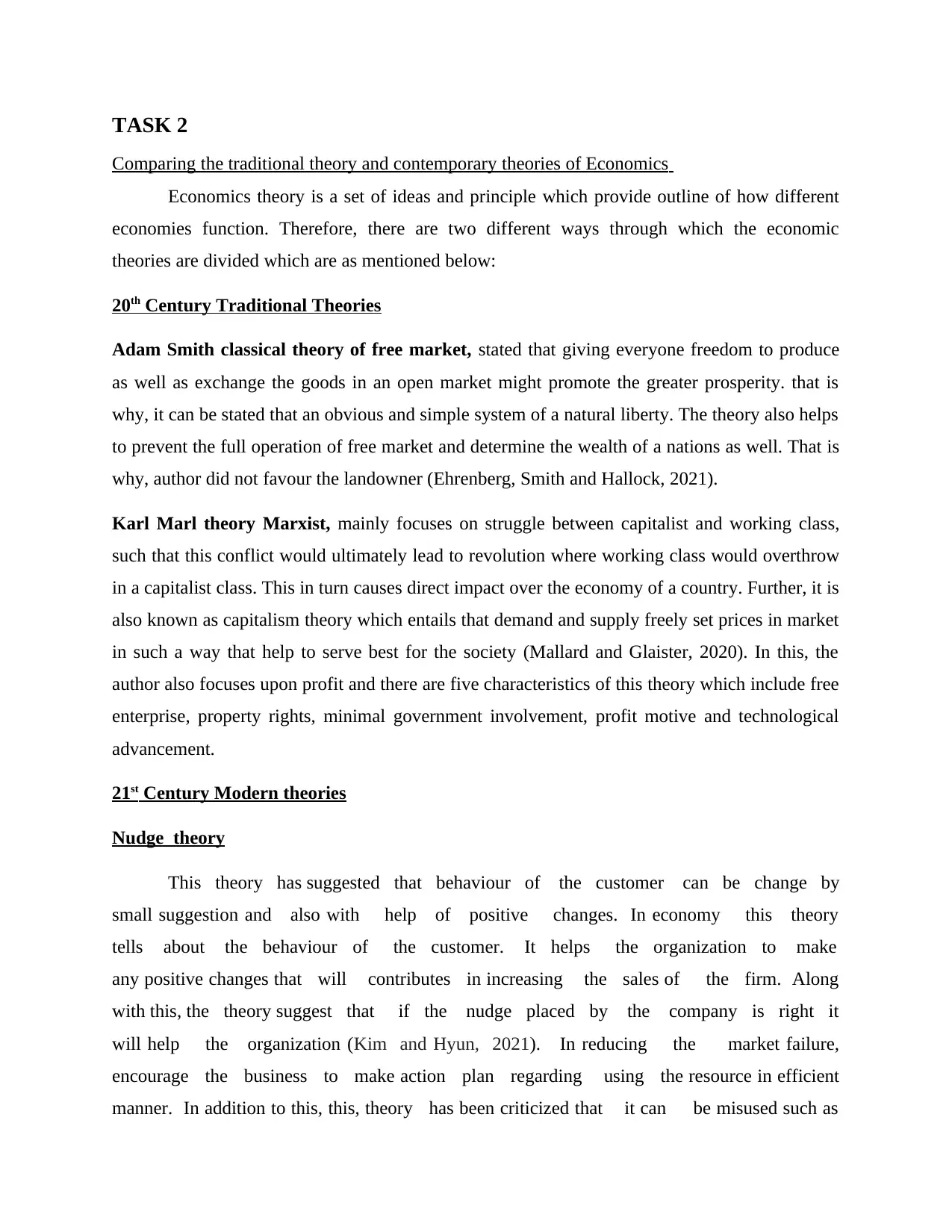
TASK 2
Comparing the traditional theory and contemporary theories of Economics
Economics theory is a set of ideas and principle which provide outline of how different
economies function. Therefore, there are two different ways through which the economic
theories are divided which are as mentioned below:
20th Century Traditional Theories
Adam Smith classical theory of free market, stated that giving everyone freedom to produce
as well as exchange the goods in an open market might promote the greater prosperity. that is
why, it can be stated that an obvious and simple system of a natural liberty. The theory also helps
to prevent the full operation of free market and determine the wealth of a nations as well. That is
why, author did not favour the landowner (Ehrenberg, Smith and Hallock, 2021).
Karl Marl theory Marxist, mainly focuses on struggle between capitalist and working class,
such that this conflict would ultimately lead to revolution where working class would overthrow
in a capitalist class. This in turn causes direct impact over the economy of a country. Further, it is
also known as capitalism theory which entails that demand and supply freely set prices in market
in such a way that help to serve best for the society (Mallard and Glaister, 2020). In this, the
author also focuses upon profit and there are five characteristics of this theory which include free
enterprise, property rights, minimal government involvement, profit motive and technological
advancement.
21st Century Modern theories
Nudge theory
This theory has suggested that behaviour of the customer can be change by
small suggestion and also with help of positive changes. In economy this theory
tells about the behaviour of the customer. It helps the organization to make
any positive changes that will contributes in increasing the sales of the firm. Along
with this, the theory suggest that if the nudge placed by the company is right it
will help the organization (Kim and Hyun, 2021). In reducing the market failure,
encourage the business to make action plan regarding using the resource in efficient
manner. In addition to this, this, theory has been criticized that it can be misused such as
Comparing the traditional theory and contemporary theories of Economics
Economics theory is a set of ideas and principle which provide outline of how different
economies function. Therefore, there are two different ways through which the economic
theories are divided which are as mentioned below:
20th Century Traditional Theories
Adam Smith classical theory of free market, stated that giving everyone freedom to produce
as well as exchange the goods in an open market might promote the greater prosperity. that is
why, it can be stated that an obvious and simple system of a natural liberty. The theory also helps
to prevent the full operation of free market and determine the wealth of a nations as well. That is
why, author did not favour the landowner (Ehrenberg, Smith and Hallock, 2021).
Karl Marl theory Marxist, mainly focuses on struggle between capitalist and working class,
such that this conflict would ultimately lead to revolution where working class would overthrow
in a capitalist class. This in turn causes direct impact over the economy of a country. Further, it is
also known as capitalism theory which entails that demand and supply freely set prices in market
in such a way that help to serve best for the society (Mallard and Glaister, 2020). In this, the
author also focuses upon profit and there are five characteristics of this theory which include free
enterprise, property rights, minimal government involvement, profit motive and technological
advancement.
21st Century Modern theories
Nudge theory
This theory has suggested that behaviour of the customer can be change by
small suggestion and also with help of positive changes. In economy this theory
tells about the behaviour of the customer. It helps the organization to make
any positive changes that will contributes in increasing the sales of the firm. Along
with this, the theory suggest that if the nudge placed by the company is right it
will help the organization (Kim and Hyun, 2021). In reducing the market failure,
encourage the business to make action plan regarding using the resource in efficient
manner. In addition to this, this, theory has been criticized that it can be misused such as
Paraphrase This Document
Need a fresh take? Get an instant paraphrase of this document with our AI Paraphraser
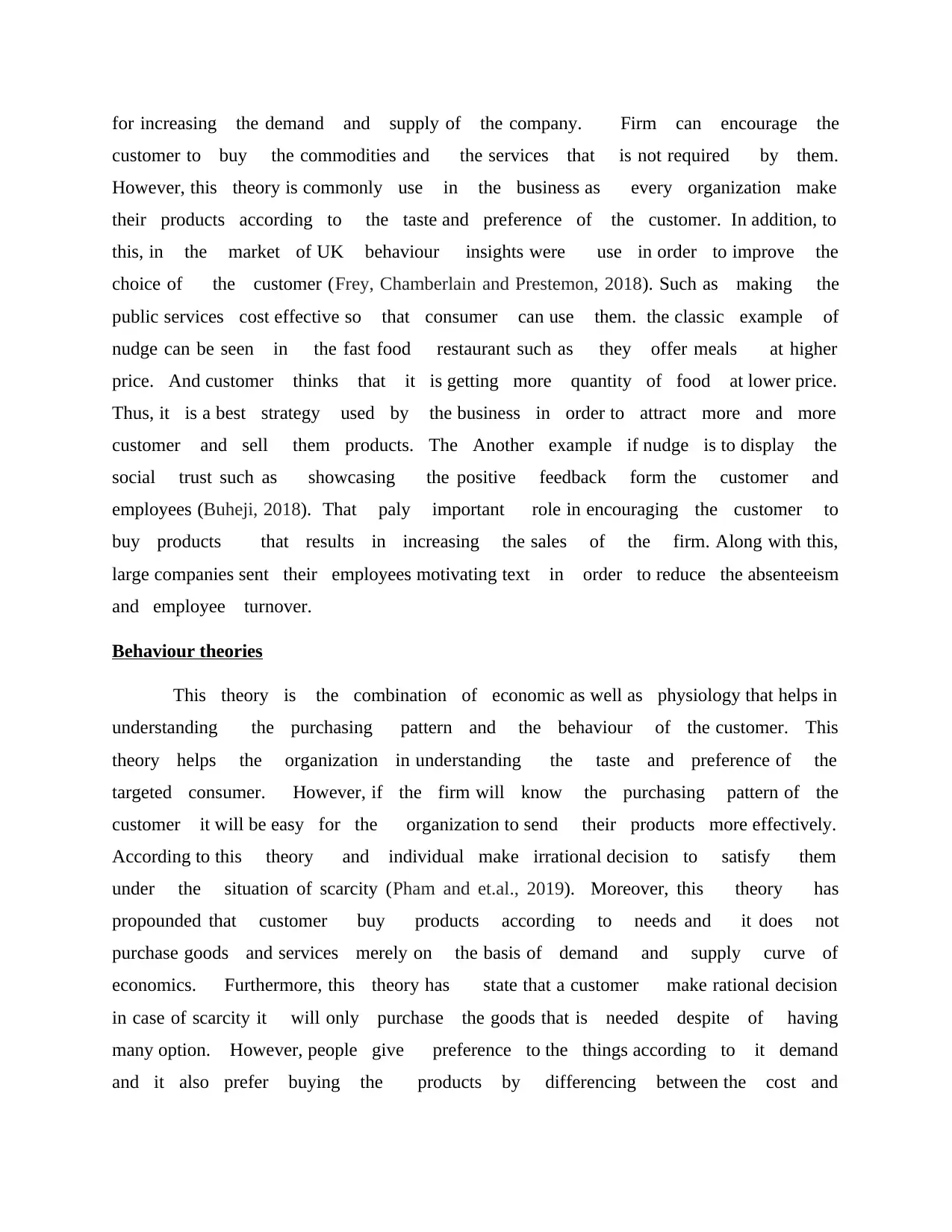
for increasing the demand and supply of the company. Firm can encourage the
customer to buy the commodities and the services that is not required by them.
However, this theory is commonly use in the business as every organization make
their products according to the taste and preference of the customer. In addition, to
this, in the market of UK behaviour insights were use in order to improve the
choice of the customer (Frey, Chamberlain and Prestemon, 2018). Such as making the
public services cost effective so that consumer can use them. the classic example of
nudge can be seen in the fast food restaurant such as they offer meals at higher
price. And customer thinks that it is getting more quantity of food at lower price.
Thus, it is a best strategy used by the business in order to attract more and more
customer and sell them products. The Another example if nudge is to display the
social trust such as showcasing the positive feedback form the customer and
employees (Buheji, 2018). That paly important role in encouraging the customer to
buy products that results in increasing the sales of the firm. Along with this,
large companies sent their employees motivating text in order to reduce the absenteeism
and employee turnover.
Behaviour theories
This theory is the combination of economic as well as physiology that helps in
understanding the purchasing pattern and the behaviour of the customer. This
theory helps the organization in understanding the taste and preference of the
targeted consumer. However, if the firm will know the purchasing pattern of the
customer it will be easy for the organization to send their products more effectively.
According to this theory and individual make irrational decision to satisfy them
under the situation of scarcity (Pham and et.al., 2019). Moreover, this theory has
propounded that customer buy products according to needs and it does not
purchase goods and services merely on the basis of demand and supply curve of
economics. Furthermore, this theory has state that a customer make rational decision
in case of scarcity it will only purchase the goods that is needed despite of having
many option. However, people give preference to the things according to it demand
and it also prefer buying the products by differencing between the cost and
customer to buy the commodities and the services that is not required by them.
However, this theory is commonly use in the business as every organization make
their products according to the taste and preference of the customer. In addition, to
this, in the market of UK behaviour insights were use in order to improve the
choice of the customer (Frey, Chamberlain and Prestemon, 2018). Such as making the
public services cost effective so that consumer can use them. the classic example of
nudge can be seen in the fast food restaurant such as they offer meals at higher
price. And customer thinks that it is getting more quantity of food at lower price.
Thus, it is a best strategy used by the business in order to attract more and more
customer and sell them products. The Another example if nudge is to display the
social trust such as showcasing the positive feedback form the customer and
employees (Buheji, 2018). That paly important role in encouraging the customer to
buy products that results in increasing the sales of the firm. Along with this,
large companies sent their employees motivating text in order to reduce the absenteeism
and employee turnover.
Behaviour theories
This theory is the combination of economic as well as physiology that helps in
understanding the purchasing pattern and the behaviour of the customer. This
theory helps the organization in understanding the taste and preference of the
targeted consumer. However, if the firm will know the purchasing pattern of the
customer it will be easy for the organization to send their products more effectively.
According to this theory and individual make irrational decision to satisfy them
under the situation of scarcity (Pham and et.al., 2019). Moreover, this theory has
propounded that customer buy products according to needs and it does not
purchase goods and services merely on the basis of demand and supply curve of
economics. Furthermore, this theory has state that a customer make rational decision
in case of scarcity it will only purchase the goods that is needed despite of having
many option. However, people give preference to the things according to it demand
and it also prefer buying the products by differencing between the cost and
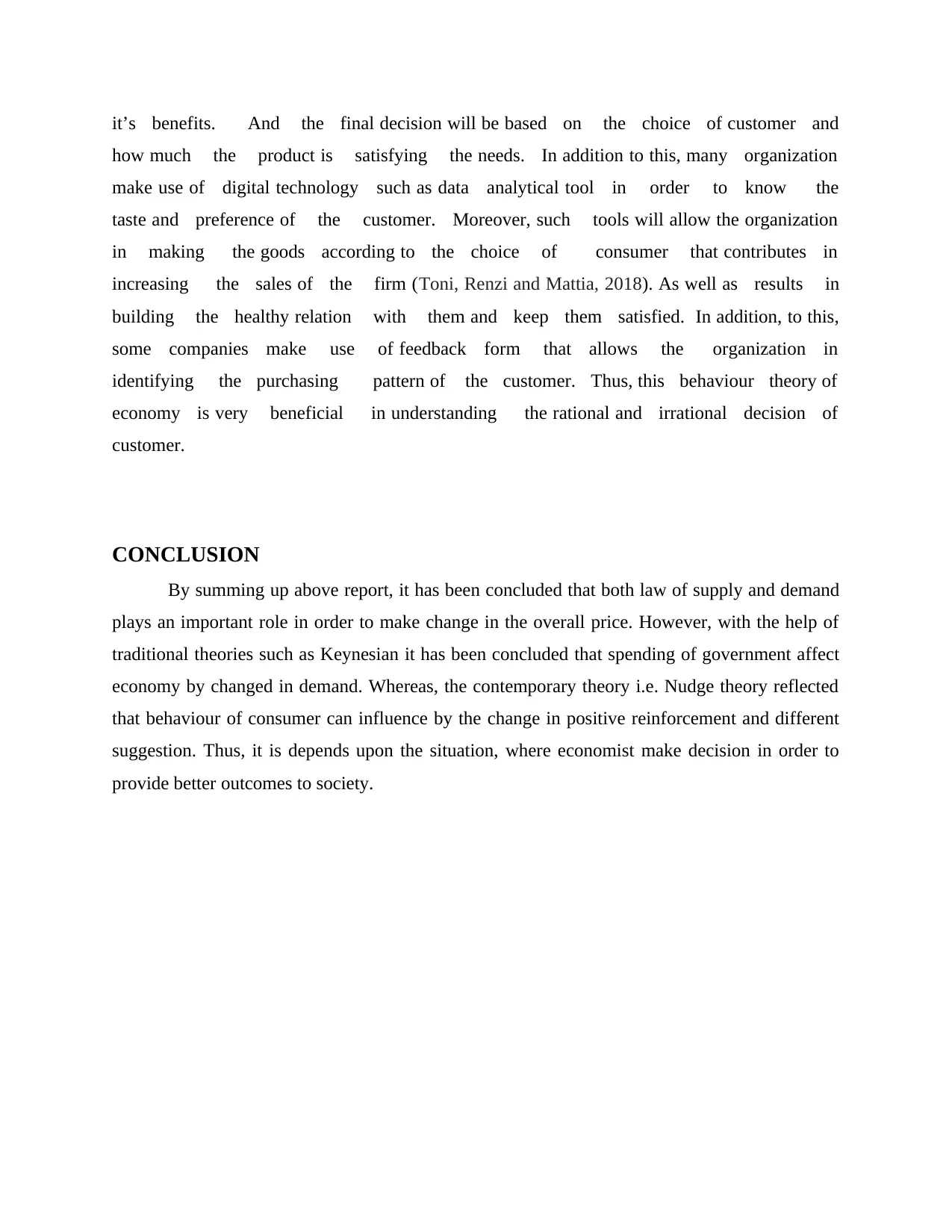
it’s benefits. And the final decision will be based on the choice of customer and
how much the product is satisfying the needs. In addition to this, many organization
make use of digital technology such as data analytical tool in order to know the
taste and preference of the customer. Moreover, such tools will allow the organization
in making the goods according to the choice of consumer that contributes in
increasing the sales of the firm (Toni, Renzi and Mattia, 2018). As well as results in
building the healthy relation with them and keep them satisfied. In addition, to this,
some companies make use of feedback form that allows the organization in
identifying the purchasing pattern of the customer. Thus, this behaviour theory of
economy is very beneficial in understanding the rational and irrational decision of
customer.
CONCLUSION
By summing up above report, it has been concluded that both law of supply and demand
plays an important role in order to make change in the overall price. However, with the help of
traditional theories such as Keynesian it has been concluded that spending of government affect
economy by changed in demand. Whereas, the contemporary theory i.e. Nudge theory reflected
that behaviour of consumer can influence by the change in positive reinforcement and different
suggestion. Thus, it is depends upon the situation, where economist make decision in order to
provide better outcomes to society.
how much the product is satisfying the needs. In addition to this, many organization
make use of digital technology such as data analytical tool in order to know the
taste and preference of the customer. Moreover, such tools will allow the organization
in making the goods according to the choice of consumer that contributes in
increasing the sales of the firm (Toni, Renzi and Mattia, 2018). As well as results in
building the healthy relation with them and keep them satisfied. In addition, to this,
some companies make use of feedback form that allows the organization in
identifying the purchasing pattern of the customer. Thus, this behaviour theory of
economy is very beneficial in understanding the rational and irrational decision of
customer.
CONCLUSION
By summing up above report, it has been concluded that both law of supply and demand
plays an important role in order to make change in the overall price. However, with the help of
traditional theories such as Keynesian it has been concluded that spending of government affect
economy by changed in demand. Whereas, the contemporary theory i.e. Nudge theory reflected
that behaviour of consumer can influence by the change in positive reinforcement and different
suggestion. Thus, it is depends upon the situation, where economist make decision in order to
provide better outcomes to society.
⊘ This is a preview!⊘
Do you want full access?
Subscribe today to unlock all pages.

Trusted by 1+ million students worldwide
1 out of 14
Related Documents
Your All-in-One AI-Powered Toolkit for Academic Success.
+13062052269
info@desklib.com
Available 24*7 on WhatsApp / Email
![[object Object]](/_next/static/media/star-bottom.7253800d.svg)
Unlock your academic potential
Copyright © 2020–2025 A2Z Services. All Rights Reserved. Developed and managed by ZUCOL.
